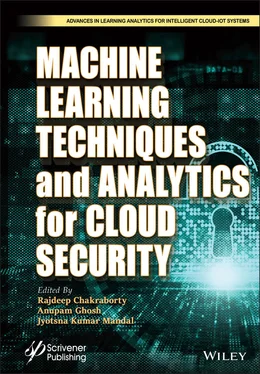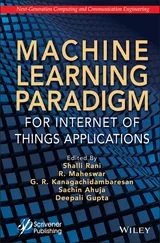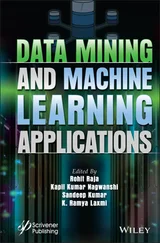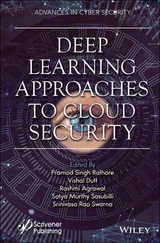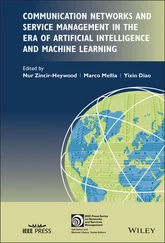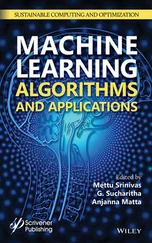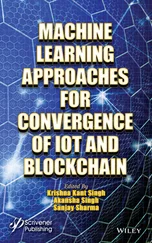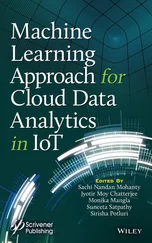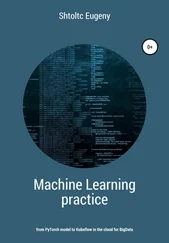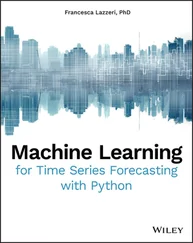Machine Learning Techniques and Analytics for Cloud Security
Здесь есть возможность читать онлайн «Machine Learning Techniques and Analytics for Cloud Security» — ознакомительный отрывок электронной книги совершенно бесплатно, а после прочтения отрывка купить полную версию. В некоторых случаях можно слушать аудио, скачать через торрент в формате fb2 и присутствует краткое содержание. Жанр: unrecognised, на английском языке. Описание произведения, (предисловие) а так же отзывы посетителей доступны на портале библиотеки ЛибКат.
- Название:Machine Learning Techniques and Analytics for Cloud Security
- Автор:
- Жанр:
- Год:неизвестен
- ISBN:нет данных
- Рейтинг книги:3 / 5. Голосов: 1
-
Избранное:Добавить в избранное
- Отзывы:
-
Ваша оценка:
- 60
- 1
- 2
- 3
- 4
- 5
Machine Learning Techniques and Analytics for Cloud Security: краткое содержание, описание и аннотация
Предлагаем к чтению аннотацию, описание, краткое содержание или предисловие (зависит от того, что написал сам автор книги «Machine Learning Techniques and Analytics for Cloud Security»). Если вы не нашли необходимую информацию о книге — напишите в комментариях, мы постараемся отыскать её.
This book covers new methods, surveys, case studies, and policy with almost all machine learning techniques and analytics for cloud security solutions
Audience The aim of Machine Learning Techniques and Analytics for Cloud Security
Machine Learning Techniques and Analytics for Cloud Security — читать онлайн ознакомительный отрывок
Ниже представлен текст книги, разбитый по страницам. Система сохранения места последней прочитанной страницы, позволяет с удобством читать онлайн бесплатно книгу «Machine Learning Techniques and Analytics for Cloud Security», без необходимости каждый раз заново искать на чём Вы остановились. Поставьте закладку, и сможете в любой момент перейти на страницу, на которой закончили чтение.
Интервал:
Закладка:
Table of Contents
1 Cover
2 Title Page
3 Copyright
4 Preface
5 Part I CONCEPTUAL ASPECTS ON CLOUD AND APPLICATIONS OF MACHINE LEARNING 1 Hybrid Cloud: A New Paradigm in Cloud Computing 1.1 Introduction 1.2 Hybrid Cloud 1.3 Comparison Among Different Hybrid Cloud Providers 1.4 Hybrid Cloud in Education 1.5 Significance of Hybrid Cloud Post-Pandemic 1.6 Security in Hybrid Cloud 1.7 Use of AI in Hybrid Cloud 1.8 Future Research Direction 1.9 Conclusion References 2 Recognition of Differentially Expressed Glycan Structure of H1N1 Virus Using Unsupervised Learning Framework 2.1 Introduction 2.2 Proposed Methodology 2.3 Result 2.4 Conclusions and Future Work References 3 Selection of Certain Cancer Mediating Genes Using a Hybrid Model Logistic Regression Supported by Principal Component Analysis (PC-LR) 3.1 Introduction 3.2 Related Methods 3.3 Methodology 3.4 Result 3.5 Application in Cloud Domain 3.6 Conclusion References
6 Part II CLOUD SECURITY SYSTEMS USING MACHINE LEARNING TECHNIQUES 4 Cost-Effective Voice-Controlled Real-Time Smart Informative Interface Design With Google Assistance Technology 4.1 Introduction 4.2 Home Automation System 4.3 Literature Review 4.4 Role of Sensors and Microcontrollers in Smart Home Design 4.5 Motivation of the Project 4.6 Smart Informative and Command Accepting Interface 4.7 Data Flow Diagram 4.8 Components of Informative Interface 4.9 Results 4.10 Conclusion 4.11 Future Scope References 5 Symmetric Key and Artificial Neural Network With Mealy Machine: A Neoteric Model of Cryptosystem for Cloud Security 5.1 Introduction 5.2 Literature Review 5.3 The Problem 5.4 Objectives and Contributions 5.5 Methodology 5.6 Results and Discussions 5.7 Conclusions References 6 An Efficient Intrusion Detection System on Various Datasets Using Machine Learning Techniques 6.1 Introduction 6.2 Motivation and Justification of the Proposed Work 6.3 Terminology Related to IDS 6.4 Intrusion Attacks on Cloud Environment 6.5 Comparative Studies 6.6 Proposed Methodology 6.7 Result 6.8 Conclusion and Future Scope References 7 You Are Known by Your Mood: A Text-Based Sentiment Analysis for Cloud Security 7.1 Introduction 7.2 Literature Review 7.3 Essential Prerequisites 7.4 Proposed Model 7.5 Experimental Setup 7.6 Results and Discussions 7.7 Application in Cloud Security 7.8 Conclusion and Future Scope References 8 The State-of-the-Art in Zero-Knowledge Authentication Proof for Cloud 8.1 Introduction 8.2 Attacks and Countermeasures 8.3 Zero-Knowledge Proof 8.4 Machine Learning for Cloud Computing 8.5 Zero-Knowledge Proof: Details 8.6 Conclusion References 9 A Robust Approach for Effective Spam Detection Using Supervised Learning Techniques 9.1 Introduction 9.2 Literature Review 9.3 Motivation 9.4 System Overview 9.5 Data Description 9.6 Data Processing 9.7 Feature Extraction 9.8 Learning Techniques Used 9.9 Experimental Setup 9.10 Evaluation Metrics 9.11 Experimental Results 9.12 Application in Cloud Architecture 9.13 Conclusion References 10 An Intelligent System for Securing Network From Intrusion Detection and Prevention of Phishing Attack Using Machine Learning Approaches 10.1 Introduction 10.2 Literature Review 10.3 Materials and Methods 10.4 Result Analysis 10.5 Conclusion References
7 Part III CLOUD SECURITY ANALYSIS USING MACHINE LEARNING TECHNIQUES 11 Cloud Security Using Honeypot Network and Blockchain: A Review 11.1 Introduction 11.2 Cloud Computing Overview 11.3 Honeypot System 11.4 Blockchain 11.6 Comparative Analysis 11.7 Conclusion References 12 Machine Learning–Based Security in Cloud Database—A Survey 12.1 Introduction 12.2 Security Threats and Attacks 12.3 Dataset Description 12.4 Machine Learning for Cloud Security 12.5 Comparative Analysis 12.6 Conclusion References 13 Machine Learning Adversarial Attacks: A Survey Beyond 13.1 Introduction 13.2 Adversarial Learning 13.3 Taxonomy of Adversarial Attacks 13.4 Review of Adversarial Attack Methods 13.5 Adversarial Attacks on Cloud-Based Platforms 13.6 Conclusion References 14 Protocols for Cloud Security 14.1 Introduction 14.2 System and Adversarial Model 14.3 Protocols for Data Protection in Secure Cloud Computing 14.4 Protocols for Data Protection in Secure Cloud Storage 14.5 Protocols for Secure Cloud Systems 14.6 Protocols for Cloud Security in the Future 14.7 Conclusion References
8 Part IV CASE STUDIES FOCUSED ON CLOUD SECURITY 15 A Study on Google Cloud Platform (GCP) and Its Security 15.1 Introduction 15.2 Google Cloud Platform’s Security Features Basic Overview 15.3 Google Cloud Platform’s Architecture 15.4 Key Security Features 15.5 Key Application Features 15.6 Computation in Google Cloud Platform 15.7 Storage in Google Cloud Platform 15.8 Network in Google Cloud Platform 15.9 Data in Google Cloud Platform 15.10 Machine Learning in Google Cloud Platform 15.11 Conclusion References 16 Case Study of Azure and Azure Security Practices 16.1 Introduction 16.2 Microsoft Azure—The Security Infrastructure 16.3 Data Encryption 16.4 Azure Cloud Security Architecture 16.5 Azure Architecture 16.6 Features of Azure 16.7 Common Azure Security Features 16.8 Conclusion References 17 Nutanix Hybrid Cloud From Security Perspective 17.1 Introduction 17.2 Growth of Nutanix 17.3 Introductory Concepts 17.4 Nutanix Hybrid Cloud 17.5 Reinforcing AHV and Controller VM 17.6 Disaster Management and Recovery 17.7 Security and Policy Management on Nutanix Hybrid Cloud 17.8 Network Security and Log Management 17.9 Conclusion References
9 Part V POLICY ASPECTS 18 A Data Science Approach Based on User Interactions to Generate Access Control Policies for Large Collections of Documents 18.1 Introduction 18.2 Related Work 18.3 Network Science Theory 18.4 Approach to Spread Policies Using Networks Science 18.5 Evaluation 18.6 Conclusions References 19 AI, ML, & Robotics in iSchools : An Academic Analysis for an Intelligent Societal Systems 19.1 Introduction 19.2 Objective 19.3 Methodology 19.4 Artificial Intelligence, ML, and Robotics: An Overview 19.5 Artificial Intelligence, ML, and Robotics as an Academic Program: A Case on iSchools—North American Region 19.6 Suggestions 19.7 Motivation and Future Works 19.8 Conclusion References
10 Index
11 End User License Agreement
List of Figures
1 Chapter 1 Figure 1.1 General architecture of hybrid cloud. Figure 1.2 Market trend of hybrid cloud [14].
2 Chapter 2 Figure 2.1 Flowchart of the methodology. Figure 2.2 K-means cluster analysis of Influenza A (H1N1) non-infected human. Figure 2.3 K-means cluster analysis of Influenza A (H1N1) infected human. Figure 2.4 K-means cluster analysis of Influenza A (H1N1) infected human. Figure 2.5 K-means cluster analysis of Influenza A (H1N1) infected human. Figure 2.6 Hierarchical cluster analysis of Influenza A (H1N1) infected human. Figure 2.7 Hierarchical cluster analysis of Influenza A (H1N1) infected human. Figure 2.8 Hierarchical cluster analysis of Influenza A (H1N1) infected human. Figure 2.9 Fuzzy c-means cluster analysis of Influenza A (H1N1) infected human. Figure 2.10 Fuzzy c-means clustering algorithm of Influenza A (H1N1) infected hu... Figure 2.11 Fuzzy c-means clustering algorithm of Influenza A (H1N1) infected hu... Figure 2.12 Concepts of type-I and type-II error in terms set. Figure 2.13 Performance measurements of the F-score, balance accuracy, and Matth... Figure 2.14 Block diagram of glycan cloud.
3 Chapter 3 Figure 3.1 Sigmoid curve. Figure 3.2 Flowchart of PC-LR algorithm. Figure 3.3 FN, TP, and FP values for colon. Figure 3.4 FN, TP, and FP values for lung. Figure 3.5 F-score for lung and colon using precision. Figure 3.6 F-score for lung and colon dataset using recall. Figure 3.7 F1 score for lung and colon dataset. Figure 3.8 Storing and accessing the data values in Amazon S3.
4 Chapter 4 Figure 4.1 IoT-based smart home automation system. Figure 4.2 Command accepting interface. Figure 4.3 Dataflow diagram for the message, command, and data transfer. Figure 4.4 Block diagram that exhibits the linkage between Uber server and IFTTT... Figure 4.5 Block diagram for Spotify server connection. Figure 4.6 Block diagram for fitness tracking using Google Fit. Figure 4.7 Implementation of PIR sensor in our system. Figure 4.8 Block diagram of the control unit. Figure 4.9 Live streaming results of the LDR sensor. Figure 4.10 API keys operational workbook. Figure 4.11 API graphs from Google Cloud Console. Figure 4.12 API data call counter log. Figure 4.13 API data push and pull traffic data graph.
Читать дальшеИнтервал:
Закладка:
Похожие книги на «Machine Learning Techniques and Analytics for Cloud Security»
Представляем Вашему вниманию похожие книги на «Machine Learning Techniques and Analytics for Cloud Security» списком для выбора. Мы отобрали схожую по названию и смыслу литературу в надежде предоставить читателям больше вариантов отыскать новые, интересные, ещё непрочитанные произведения.
Обсуждение, отзывы о книге «Machine Learning Techniques and Analytics for Cloud Security» и просто собственные мнения читателей. Оставьте ваши комментарии, напишите, что Вы думаете о произведении, его смысле или главных героях. Укажите что конкретно понравилось, а что нет, и почему Вы так считаете.
